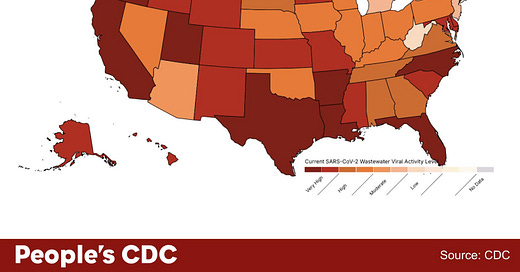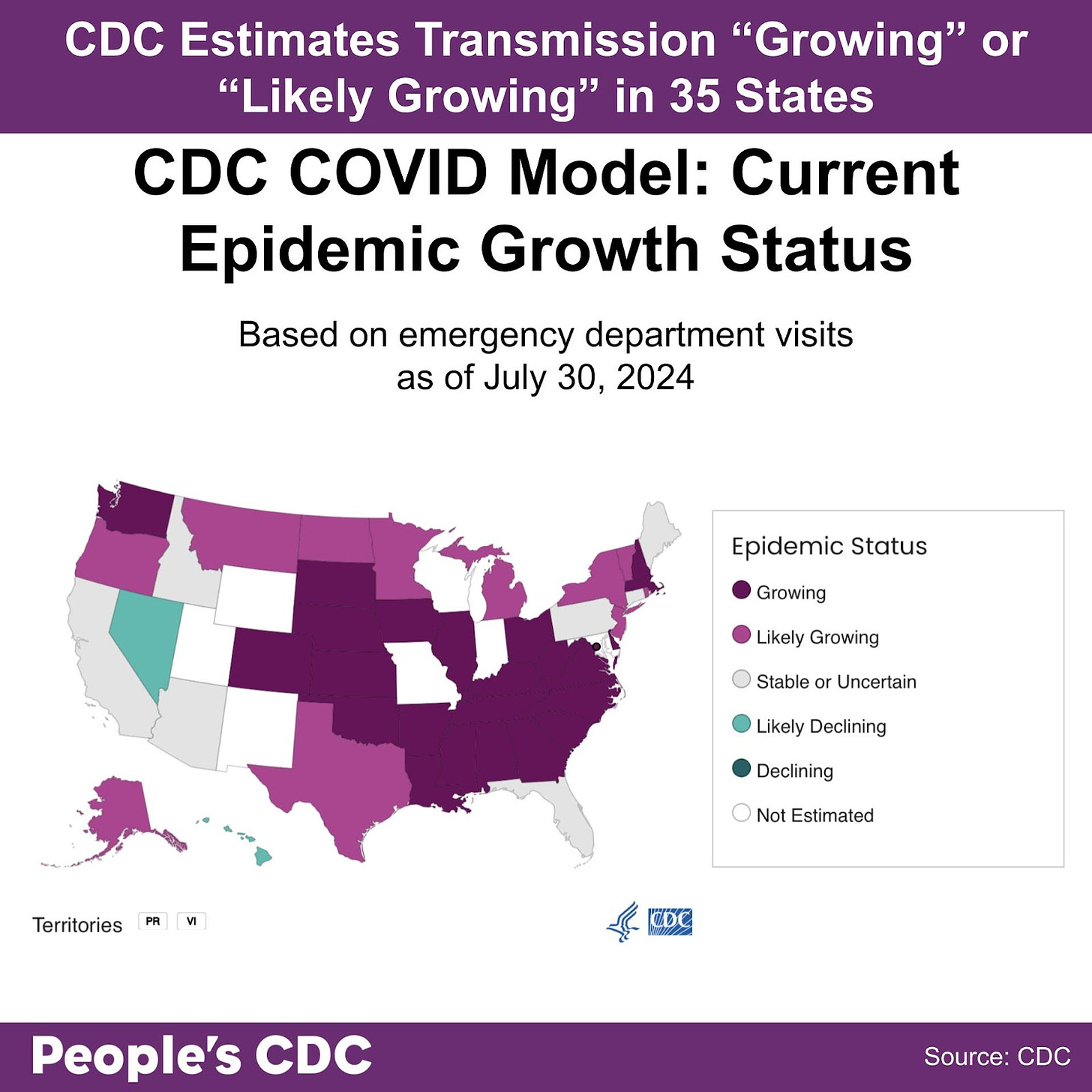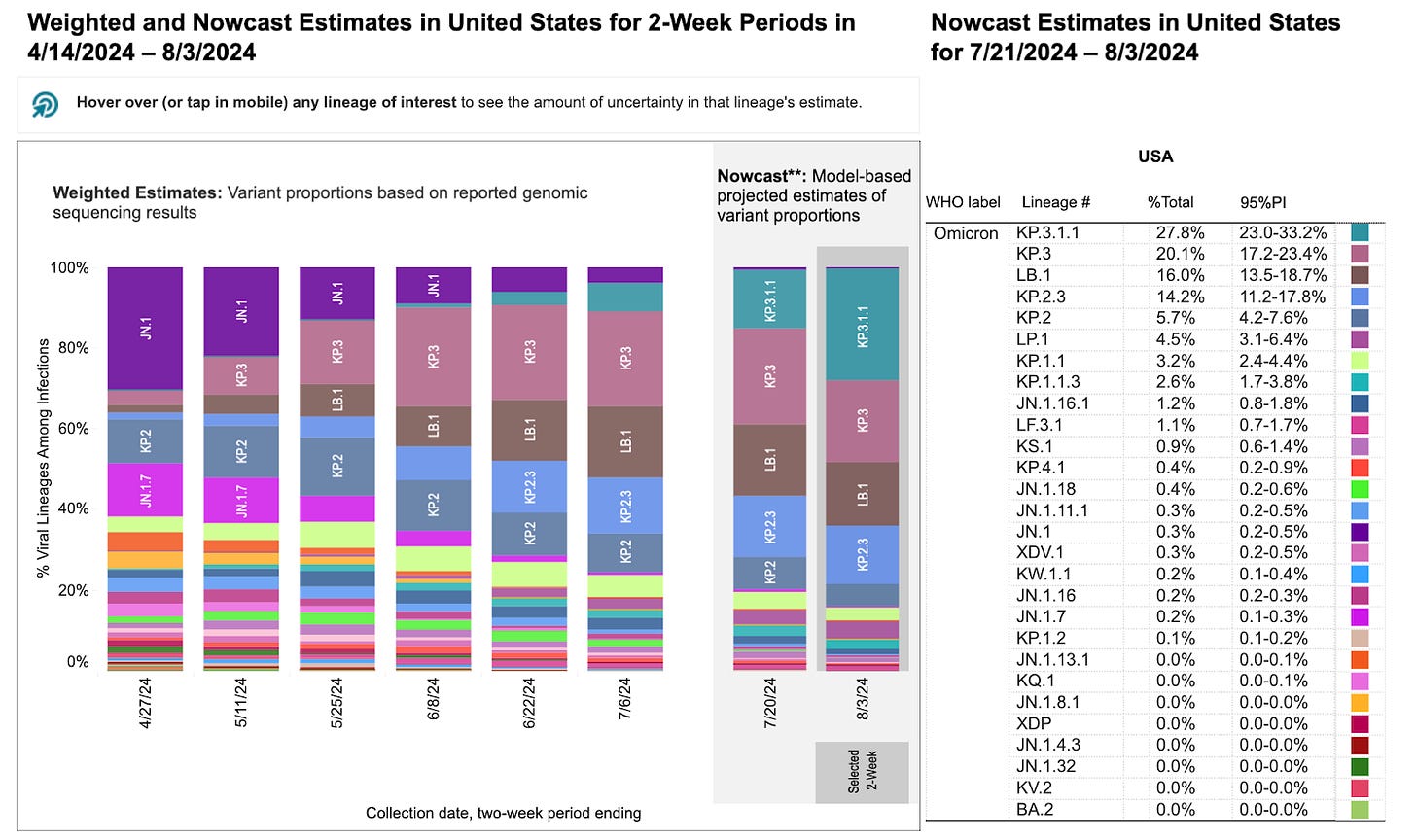People's CDC, August 5, 2024, COVID-19 Weather Report
COVID wastewater levels continue to increase, mask and vaccine mandates are effective at curbing transmission, and the CMS is requiring hospitals report COVID infection data.
Wins
Thanks to ongoing advocacy within our community, including public comment to CMS and letter to Congress, on August 1, 2024, The Centers for Medicare and Medicaid (CMS) established an official policy requiring healthcare systems to report COVID infections on a weekly basis starting November 1, 2024.
CMS also committed to considering and addressing COVID as part of the Hospital-Acquired Condition (HAC) Reduction Program in the future.
Thank you to everyone who submitted comments, wrote letters, and shared campaigns to make this happen. Together, we are building power towards increased access to the data needed for increased reliability, consistency, and accuracy in viral forecasting.
The Weather
Wastewater levels continue to rise across the country. As of August 2, 2024, wastewater viral activity is either “High” or “Very High” in 44 states, according to the Wastewater Surveillance System (NWSS) dashboard. Viral activity is “Moderate” in 4 states, “Low” in 2 states, and data is unavailable for North Dakota, Guam, Puerto Rico, and the U.S. Virgin Islands.
COVID transmission is the highest it has been since the winter surge. As such, we urge you to continue taking precautions by employing multiple layers of protection, such as wearing a well fitted respirator (N95 or KN95), testing, staying updated with the most available vaccine, and improving ventilation.
The Wastewater COVID-19 National and Regional Trends dashboard shows that COVID wastewater levels are continuing to increase nationally, with the West still showing the highest level since June 15, 2024, but the South sees the largest increase in the two-week period leading up to July 27, quickly catching up to the level only slightly below the West. Levels in the Northeast and Midwest are slightly increasing.
If you would like to access information on COVID wastewater levels at a local level, you can check the CDC’s state/territory trends page, the WastewaterSCAN dashboard, or state/local public health wastewater trackers, if they are available.
According to the CDC Center for Forecasting and Outbreak Analytics dashboard, COVID levels are “growing” or “likely growing” in 35 states and territories as of July 30, 2024. Levels are “stable or uncertain” in 7 states, “likely declining” in two states, and “not estimated” in 9 states.
This model utilizes emergency department visit data to estimate COVID transmission’s Rt, which is an estimate of the average number of new infections caused by each infectious person. An Rt greater than 1.0 indicates that infections are growing, while an Rt less than 1.0 indicates that they’re declining. It is also important to note that this is very likely an undercount, as beginning May 1st of this year hospitals are no longer required to report COVID-19 Hospital Data, although we will again have hospital data thanks to CMS’s new requirement starting November 1, 2024.
Variants
As of July 6, 2024, KP.3 is still the prevailing variant, at 23.3%, as per the CDC’s variant tracking dashboard. KP.3.1.1 is expected to overtake KP.3 according to Nowcast modeling by August 3, 2024, increasing to 27.8%. KP.3 is predicted to decrease to 20.1%, with LB.1 and KP.2.3 at 16% and 14.2% respectively.
Graphic source: CDC Variant Tracker
Long COVID
On Friday, August 2nd, US Senator Bernie Sanders (I-VT) announced the introduction of the Long Covid Research Moonshot Act of 2024 (S.4964). This legislation is co-sponsored by US Senators Tammy Duckworth (D-Ill), Tim Kaine (D-VA), Ed Markey (D-Mss), Tina Smith (D-Minn), and Peter Welch (D-Vt) and would provide $1 billion in funding per year, for 10 years for the research and treatment of Long COVID. The bill’s summary has been provided by Senator Sanders..
Other
A new study published in JAMA Health Forum reveals that if all 50 U.S. states employed COVID precautions similar to those utilized in states with the most stringent protocols, excess deaths would have been 10-21% lower than the amount of reported deaths analyzed in the study (1.18 million). Mask and vaccine mandates were “associated negatively with excess deaths,” meaning that they contributed reduced deaths overall. Importantly, there is a significant difference in excess deaths between states with strong vs. those with weak mandates. These findings further emphasize the importance of both masking and vaccination as measures that help curb transmission, and by extension, preventing excess deaths.
As the Summer Olympics in Paris continue this week, the People’s CDC regrets that robust preventative measures, some of which were utilized in the two previous Olympic Games in Tokyo (2021) and Beijing (2022) in order to prevent the unmitigated spread of COVID from global event that brings together thousands of athletes from across the world. Media outlets continue to frame this Olympics as “post-pandemic,” and “post-COVID,” yet the number of world-class athletes sidelined by past or current COVID infections continues to grow. In real time, we are witnessing the outcome of institutions minimizing and eliminating the layers of protection needed to prevent the creation of superspreaders of this magnitude.
The Olympics relies on the unpaid labor of the massive volunteer force organized by a host city’s organizing committee. We’ve previously seen a mass resignation by these workers during the postponed Tokyo Summer Games due to COVID concerns. Of the 80,000 volunteers committed to working the events that summer, 10,000 resigned. The Paris games have already seen the organized resignation of Olympic and Paralympic volunteers resigning due to that lack of COVID precautions implemented by organizers, putting the health of athletes, volunteers, attendees, and Parisian residents at risk.
Take Action
On August 22, 2024, the CDC’s Healthcare Infection Control Practices Advisory Committee (HICPAC) will be holding its next meeting, where they will discuss COVID isolation policies within hospital settings. In the past, we have pressured them to take this issue more seriously, and as a result they will be reviewing their infection control guidelines once more. As such, continuing to pressure HICPAC in order to ensure they implement universal masking within healthcare settings is of utmost importance. HICPAC will be accepting oral comments until August 12, 2024, and requests to make an oral comment can be submitted through this page.
The CDC will be hosting a remote session on August 6, 2024 where the CDC Director and other healthcare professionals will be discussing how to prepare clinics for the fall and winter respiratory virus season. The website description mentions that the learning objectives include identifying ACIP’s updated recommendations for flu, COVID, and RSV, as well as discussing vaccination as a measure that should be emphasized.
Again, the CDC is clearly refusing to contend with the facts and make explicit claims. They have recently updated their guidelines to specify that COVID is not limited to the winter season, and instead has multiple peaks a year. Therefore, providing one informational session for winter in particular is insufficient. Additionally, the emphasis on vaccination with no mention of masking suggests that masking is not necessary, when it is a very effective tool at curbing transmission. The session will also include a live Q&A, where participants can ask questions directly to the session holders (including the CDC Director, Mandy Cohen). Register in advance and inquire as to why the CDC is not doing more to address COVID infections year-round, as well as minimizing the importance of masking.
The CDC’s Bridge Access Program is slated to end this month. Continue urging your elected officials to fund programs that will ensure no-cost access to vaccines by sending them a letter through our Action Network Campaign.
Notes: 1) The numbers in this report were current as of 8/2/2024. 2) Check out the links throughout & see our website for more at https://peoplescdc.org. 3) Subscribe to our newsletter: People’s CDC | Substack.






